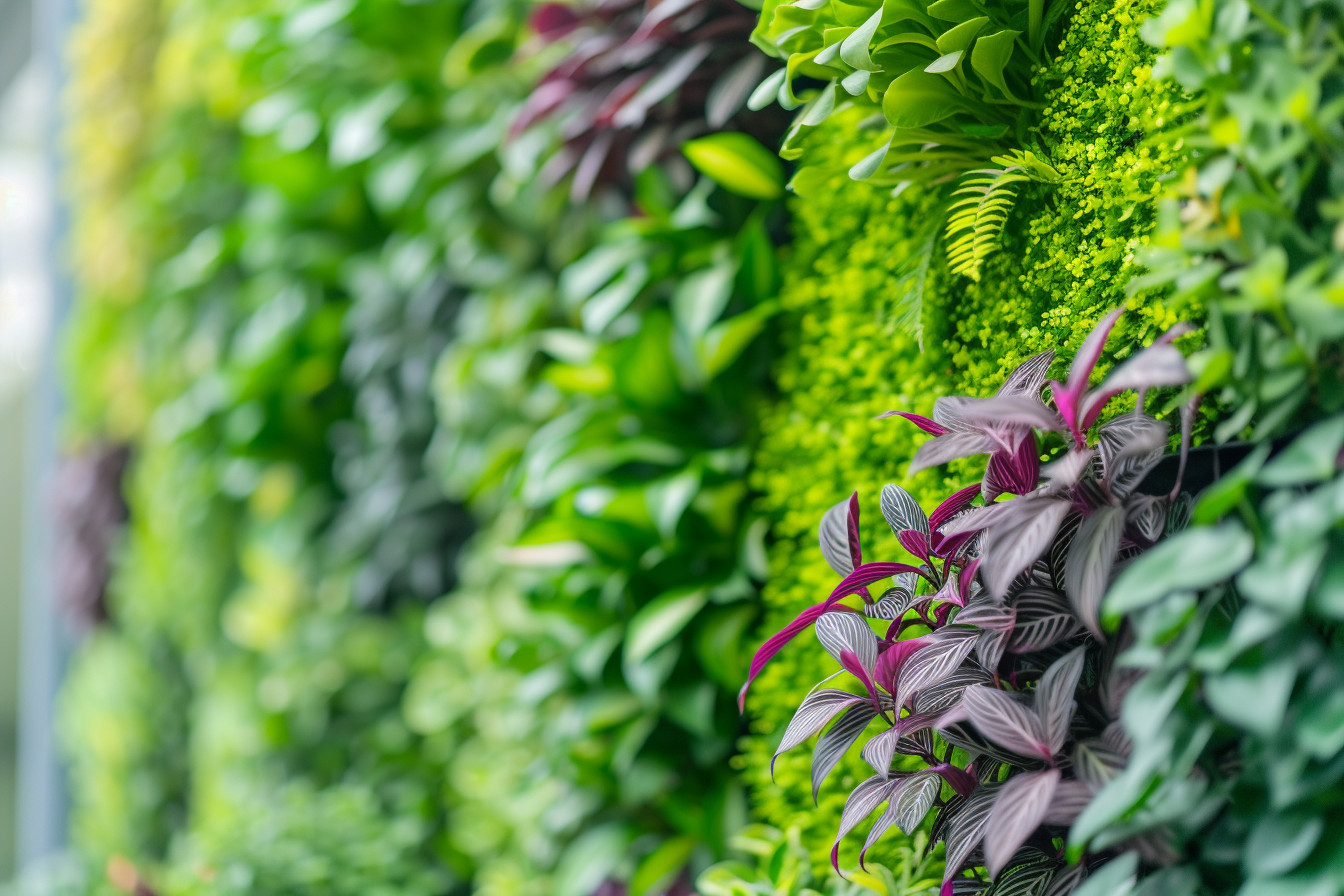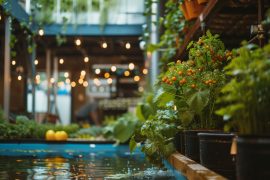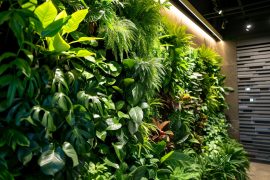Ever wondered about turning your home or office into a lush, oxygen-rich oasis? Well, vertical gardens for air purification are an innovative and beautiful way to do just that. It’s like hanging a breath of fresh air on every wall. I’ve seen firsthand how transforming any indoor space with these living walls can not only elevate the mood but also significantly purify the air.
Let me tell you something, folks: plants aren’t just pretty faces; they’re hardworking warriors in our fight against pollutants. Research shows how certain types can actually scrub harmful toxins right out of the environment while pumping in some much-needed O2. This isn’t science fiction; it’s garden magic at its finest, making use of nature’s very own filters!
Now, diving deeper beyond their aesthetic charm, vertical gardens harness a principle that is rather simple, yet profoundly impactful: more greenery means cleaner breathing spaces! By integrating thoughtful designs and choosing specific plant varieties, we optimize both harmony within our environments as well as health benefits.
There are stories galore where installing these verdant installations has transformed sick building syndromes into sanctuaries of wellness.
Let’s explore together. Shall we dive into an educational journey filled with inspiration, history, and hands-on tips to bring this captivating gardening technique closer to reality?
Air Purification with Vertical Gardens
Diving right into the heart of vertical gardening, it’s a breath of fresh air—literally. These lush installations are more than just eye candy; they’re powerful tools in the fight against indoor pollution. Imagine walking into a room where plants from floor to ceiling work tirelessly, scrubbing the air clean.
Vertical gardens have caught on for several reasons, but their ability to purify air might be one of the most compelling. Studies show that specific plants can remove toxins like formaldehyde, benzene, and trichloroethylene from our environments. What’s cooler? You don’t need an expansive garden space to reap these benefits—a wall will do just fine!
Let me share some hard data:
| Plant Type | Pollutant Removed |
|---|---|
| Spider Plant | Formaldehyde |
| Snake Plant | Benzene |
| Peace Lily | Trichloroethylene |
I was chatting with Linda McPherson—the owner of Green Oasis Living Walls—and she shared how schools and office buildings have seen noticeable improvements in indoor air quality after installing vertical gardens.
“It’s not only about aesthetics,” she said knowingly as we sat amidst her beautifully designed living walls at her showroom. “Students’ attendance improved; employees reported better concentration.”
Taking things down my memory lane, I remember reading this fascinating study conducted by NASA during which certain houseplants were identified that excel at purifying indoor spaces through photosynthesis (cue your high school biology flashback). Mother Nature has gifted us mini vacuum cleaners, so why aren’t we making full use of them?
Plants coupled together in beautifully crafted structures market themselves as natural healers while standing gorgeously under sunlight, peeping through windows, or using LEDs specialized for plant growth if you prefer going techy indoors!
Now let me paint another story real quick: I was visiting Japan last spring when I stumbled upon Akihiro Takahashi’s quaint cafe nestled within Shibuya district, boasting quiet retreats shaped by stunning pothos cascading downwards. Tales whispered among leaves speak volumes indeed about finding peace amid bustling city life!
These conversations between people passionate about enriching lives via greener routes always come back, narrating increased visitor satisfaction wherever there is conscious effort caked towards green innovations.
How Vertical Gardens Improve Indoor Spaces
Vertical gardens aren’t just a treat for the eyes; they’re literally a breath of fresh air in our homes and workplaces. Imagine this: plants climbing up your living room wall, not only elevating the aesthetics but actively purifying the air you breathe. It’s like having your own personal oxygen bar, minus the noise and commotion.
One of my favorite things about vertical gardens is their versatility. They can thrive in spaces large or small, making them perfect even for those among us who are convinced we don’t have enough space to greenify our environments. And with various systems available—from hydroponic setups that require no soil to simpler pocket planters—there’s something out there for every level of gardening expertise.
Now let me share some numbers that blew my mind:
- Plants can remove up to 87% of volatile organic compounds (VOCs) every 24 hours.
- According to NASA studies, indoor plants like spider plants and snake plants significantly improve air quality.
| Plant Type | % VOC Removal |
|---|---|
| Spider Plant | Up to 95% |
| Snake Plant | Up to 90% |
Beyond pulling toxins from the air, these leafy walls do wonders for mental health too. There’s ample research suggesting that being around greenery reduces stress levels—a pretty neat side effect, if you ask me! Strolling by a lush vertical garden on your way to grab another cup of coffee during work breaks? That mini-nature immersion might be more rejuvenating than caffeine itself.
Types of Indoor Plants for Vertical Gardens
Stepping into the world of vertical gardening feels like encountering a hidden layer of nature’s magic. It’s not just about adding greenery to your indoor spaces; it’s about creating an ecosystem that breathes life into our homes and workplaces, purifying the air we breathe daily.
Selecting the right plants is crucial when designing your own sanctuary. You’ll want varieties known not only for their beauty but also for their ability to clean houses! The Spider Plant (Chlorophytum comosum) reigns supreme in this realm with its NASA-stamped approval as an air-purifying champion. When you see those baby spiderettes cascading down, it’s hard not to marvel at how seamlessly they contribute both charm and health benefits wherever they are placed.
Peace Lily (Spathiphyllum), English Ivy (Hedera helix), and various fern species are some standout examples worth integrating too, because, guess what? They’re pretty adept at breaking down airborne toxins, turning them into substances these plants can actually use!
Now let’s talk practicality within aesthetics: design considerations must keep growth habits in sharp focus since each plant brings something unique table-wise.
- Spider plants thrive under moderate light conditions—perfect if bright sunlight isn’t on tap all day long!
- In contrast, English Ivies drape elegantly, requiring minimal upkeep aside from regular watering, making them ideal for hanging compadres up high or snaked around other structures.
Designing and Installing a Vertical Garden
Let’s dive into the world of vertical gardens with an ease that feels like strolling through your favorite park. Imagine transforming an empty wall or small indoor space into a lush, green oasis. That sounds rejuvenating, right? That’s exactly what we’re going for when designing and installing these living artworks.
The first step in this process is deciding on the location. You’ve got to think about light exposure here since plants are pretty picky about their sunbathing habits—some love basking all day while others prefer just a hint of dawn or dusk. It goes beyond aesthetics; it’s understanding which part of your home can provide those conditions consistently.
Now talk about design specifics! What do you envision? A herb haven to level up kitchen concoctions, perhaps, or maybe something floral breathing new life (and oxygen!) indoors regardless if winter looms outside?
- Inspiration could come from anywhere.
- Think cafes bursting at seams with ivies.
- Or balconies where succulents defy gravity.
Materials play heroes behind-the-scenes, supporting plant friends without stealing the spotlight.
- Pots need drainage (we’re not making mini marshlands).
- Frames robust enough to hold our plant buddies securely
- Felt pockets are better for roots, tapping away moisture conservatively.
Installation kicks off almost DIY-esq, but consider enlisting savvy pals because two heads (or hands) typically birth fewer “oops” moments than solo acts might invite (definitely speaking from experience here!). Start layer-wise from the baseline upwards, ensuring a firm fixture and avoiding later slippage resembling garden avalanches (trust me, no one wants that).
Remember, integration isn’t instant magic presto, though progress visually WOWs quite fast, elevating bland spaces majestically within weeks, even nurturing air quality alongside urban esthetics beautifully-fetted French vibes, anyone?
Air-purifying species emerge as vital players, flipping script on notorious indoor pollutants, spinning tales, taking fresh breaths, and saying thanks for every additional leaf unfurling.
Keeping your vertical garden thriving doesn’t just add a touch of green to indoor spaces; it’s like hanging pieces of art that constantly evolve. But, let me tell you, while these living artworks can transform the air quality and aesthetic in our homes or offices, they do require a bit more attention than your average potted plant.
First things off: tempering is crucial, but overdoing it is one quick way to say goodbye to those precious plants. Unlike traditional gardens, where excess water might drain away easily, vertical gardens have limited escape routes for H2O. So here’s my tip—invest in a drip irrigation system that evenly distributes tiny droplets of water across each section, ensuring roots get exactly what they need without drowning them out. It sounds high-tech, but trust me when I say this little gadget will soon become your best friend.
Light exposure comes next on the list since not all areas within an indoor environment receive equal amounts of sunshine (or any at all). Some folks assume low light means no go for greens, but embracing shade-loving species could turn those dimly lit spots into lush focal points! Just be mindful about rotating plants from lower-light zones towards bright ones occasionally; giving everyone their moment under the sun ensures even growth and keeps leafy friends happy.
Nutrients are another factor worth chatting about because, yep—you guessed right—they run out eventually, especially when confined in small pockets against walls as opposed to spread-out root systems underground. We’re talking fertilizer, which needs replenishment every so often depending upon type, timing, and size, among other factors. Personal experience taught many lessons, including that there is such a thing as too much nutrition. Does the sound of brown leaves sound familiar?
Let’s delve briefly into pests—part of the gardening game enthusiasts know. That said, simple weekly checks keep pesky bugs at bay. Plus, natural remedies work wonders. ThinkNeem oil insecticidal soap discourages unwanted visitors, interrupting the serene vibe we’re striving for.
So remember patience, guidance, tender love, and care. These maintenance tips hone the connection between people and nature through well-crafted, orderly-maintained vertical arrangements, transforming everyday surroundings, and uplifting sanctuaries.
Case Studies: Successful Implementation of Vertical Gardens for Air Purification
Delving into the world of vertical gardens, especially those known for their air purification capabilities, offers a refreshing glimpse at how we can integrate nature’s beauty and functionality into our indoor spaces. Through specific examples, let’s explore this innovative approach to greening.
One notable example is found in the heart of Milan with the Bosco Verticale, or “Vertical Forest.” This pair of residential towers don’t just stand out because they’re covered head-to-toe (or rather floor-to-rooftop) in more than 900 trees and over 2,000 plants; these living entities actively contribute by filtering pollutants from the surrounding area while producing oxygen, making it an archetype project marrying architecture with natural elements beautifully. It takes bringing forestry right amongst urban sprawl!
Another inspiring story unfolds within Singapore’s Changi Airport, renowned not only for its remarkable efficiency but also for its ‘Green Heart.’ Inside Jewel Changi Airport thrives a colossal indoor garden featuring thousands upon thousands of plants dispersed vertically across several levels, accompanying walking trails that weave through lush landscapes.
The concept cleverly incorporates waterfalls cascading amidst green foliage, which, besides captivating all senses, helps purify airport air, allowing travelers an immediate connection to tranquility despite bustling flight schedules.
Final Thought
This is the end of our deep dive into vertical gardens and their role in purifying air in indoor settings. I’ve taken you through a journey, highlighting how these living walls not only transform mundane spaces but also harbor significant health benefits.
Let’s summarize the key takeaways:
- Vertical gardening serves as an aesthetic feature while actively improving indoor air quality.
- Through photosynthesis, plants in vertical gardens remove pollutants from the air we breathe, making our environments healthier.
Reflecting on my own experiences with installing a small green wall at home made me truly appreciate nature’s power right inside my living room. It was mesmerizing to see life flourish vertically; it added much more than just visual appeal—it became a source of daily peace for me.








